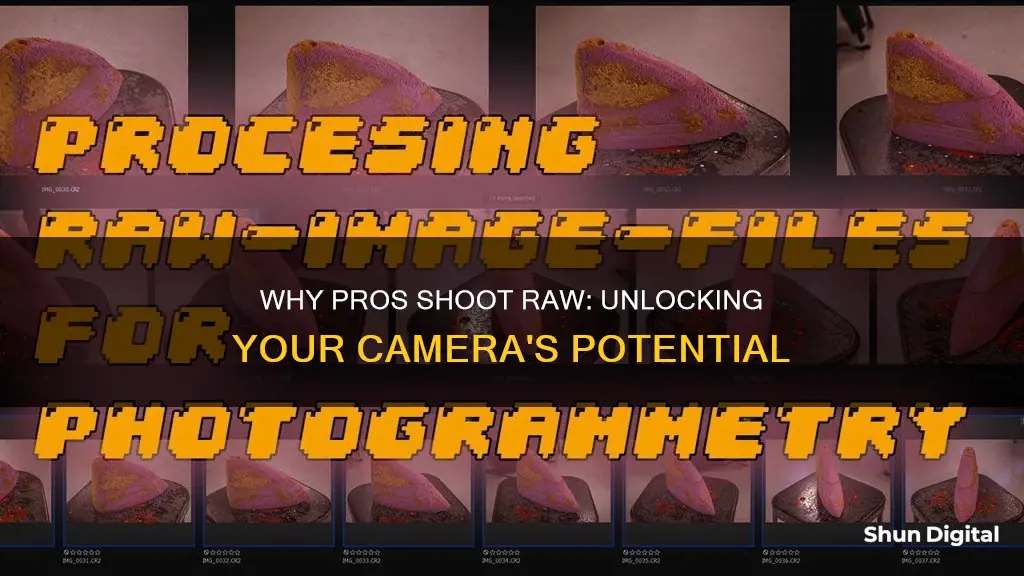
Shooting in RAW format has a huge impact on the final image. RAW files are uncompressed, unprocessed data from the image sensor of a digital camera, motion picture film scanner, or image scanner. They are often referred to as digital negatives as they capture the radiometric characteristics of a scene, including the physical information about the light intensity and colour of the scene.
Each camera manufacturer has its own RAW file format, for example, Canon RAW files are .CR2 or .CR3, while Nikon uses .NEF.
What You'll Learn

RAW files are uncompressed, so they retain all of the image data
When shooting in RAW format, the camera saves an uncompressed version of the image file. Essentially, the camera takes the image data from the sensor and saves it in an unedited and uncompressed format on the memory card.
This means that RAW files retain all of the image data captured by the camera's sensor. This results in much larger file sizes compared to compressed formats like JPEG, but offers several advantages for photographers.
One of the main benefits of shooting in RAW is the ability to retain all the valuable image data. This allows for greater flexibility in post-processing, as photographers can recover details in bright skies or dark shadows, adjust white balance, and fine-tune sharpness and noise reduction.
Another advantage of RAW files is that they provide more control over the final image. Since RAW files are uncompressed, they contain a massive amount of image information, allowing for more precise adjustments during editing.
Additionally, RAW files offer higher image quality. The uncompressed data captures the full dynamic range and radiometric characteristics of the scene, preserving all the information captured at the time of exposure.
While shooting in RAW has its advantages, there are also some drawbacks. RAW files require more storage space and can slow down the camera's performance, especially during burst shooting. They also need to be processed and edited before they can be shared or printed, adding an extra step to the workflow.
In summary, shooting in RAW format offers uncompressed image files that retain all the data captured by the camera sensor. This provides photographers with greater flexibility, control, and image quality during post-processing, but comes with the trade-off of larger file sizes and additional processing time.
Export ACR Files: Adobe Camera Raw Guide
You may want to see also

RAW files capture and save the most detail
For example, a JPEG file saves 256 shades of color. This seems like a lot until you know that RAW files collect more than 65,000 shades of color. A JPEG takes all the colors in the scene and reduces them down to just a few hundred. This is one reason a JPEG is smaller than a RAW image. But you cannot get these colors back. They are gone for good.
With a RAW file, there’s a massive amount of image information available, meaning you can recover skies that are too bright by reducing their brightness and increase the shadows so they are brighter. You can also use this information when post-processing the photo to bring out detail in the shadows or the highlights. You have much more flexibility when it comes to adjusting an over-or underexposed image.
Storage is inexpensive. You may need to buy larger SD cards or an external hard drive to hold your RAW images. But with each image, you are saving more information.
Charging Your SP815UZ: Battery Power Basics
You may want to see also

RAW files allow for better brightness adjustments
When shooting in RAW, you have much more flexibility to adjust the brightness of your images. This is because RAW files capture a wider dynamic range of colours and shades than JPEGs.
JPEGs are compressed image files, which means they have already been processed by your camera and are ready to use straight away. However, this also means that they have already been edited and adjusted by your camera, and there is less flexibility to make changes to the image without causing image degradation.
On the other hand, RAW files are uncompressed and unprocessed. They are sometimes referred to as 'digital negatives' because they are the raw data captured by your camera's sensor. This means that they give you much more flexibility to edit the image after the fact.
For example, if you have taken a photo where the sky is too bright, or the subject is too dark, you can use a RAW file to recover the sky by reducing its brightness and increase the brightness of the shadows. This is because there is a "massive amount of image information available" in a RAW file.
In addition, RAW files contain more shades of colour than JPEGs. JPEGs are 8-bit image files and can store up to 16.8 million colours, whereas RAW files can store up to 68.7 billion colours (in 12-bit RAW) or 4.4 trillion colours (in 14-bit RAW). This means that you can make much more dramatic changes to the brightness of a RAW image without causing image degradation.
Charging Your Lumix Camera: USB Guide
You may want to see also

RAW files allow for better white balance adjustments
When shooting in RAW, white balance is not applied to the RAW file. However, white balance is used for the embedded preview image. If the white balance is set incorrectly, the colours will be off in the preview image.
Shooting in RAW allows for greater flexibility when editing white balance. When shooting in JPEG, the white balance is already balanced, and the image looks more finished straight out of the camera. When shooting in RAW, the image will initially look less impressive, but the potential for creating something more impressive is there.
When shooting in RAW, you can change the white balance after the fact much more easily, meaning it is a great deal easier to adjust the tone of the image in post-processing. This is particularly useful when the light source is quite warm, as it can make the image look yellow. Adjusting the white balance after the fact can make a yellow bowl look white, and the rest of the food look more natural as a result.
Shooting in RAW also allows for greater control over the final image. This is particularly noticeable when you are shooting a scene with either dark shadows or bright highlights – the RAW editor will let you recover much more information than the JPG.
Baby Camera Cloud Storage: Charging for Your Dog's Memories?
You may want to see also

RAW files are meant to be post-processed
When shooting in RAW, the camera defers most of the processing to the photographer. This means that the photographer has to process the image file in a raw converter or photo editing software like Adobe Lightroom or Photoshop. This extra step in the workflow is why many photographers choose to shoot in JPEG instead, as it saves time.
However, RAW files offer much more flexibility in post-processing than JPEGs. They contain a massive amount of image information, which means that photographers can recover skies that are too bright and increase the brightness of dark subjects. They can also make changes to the white balance, sharpness, and noise reduction, which are difficult to do with JPEGs.
In summary, RAW files are meant to be post-processed because they are unprocessed data from the camera's sensor. This gives photographers greater control over the final image but requires additional time and work to edit the images.
Charging Your Bloggie Camera: A Step-by-Step Guide
You may want to see also
Frequently asked questions
A RAW file is an uncompressed, unprocessed file format that contains all the data the camera is capable of collecting from a scene.
Shooting in RAW gives you more control over the final image. You can adjust the brightness, shadows, and highlights, as well as the white balance and colours, to create a personalised look.
RAW files are much larger than JPEGs, so they take up more space on your memory card and hard drive. They also require additional processing time, as the image needs to be processed before it can be shared.
To shoot in RAW, access your camera's file settings, usually found in the menu, and select RAW instead of JPEG.
You will need a photo editing software that is compatible with your camera's RAW files, such as Lightroom or Photoshop.







